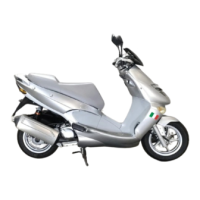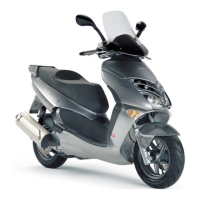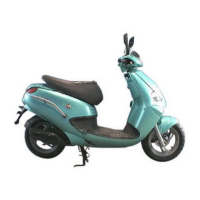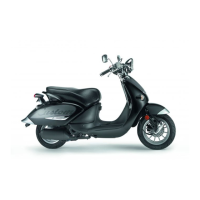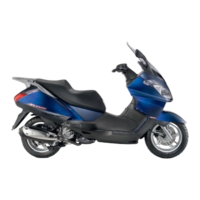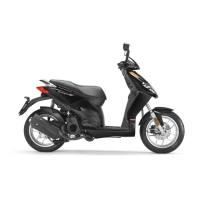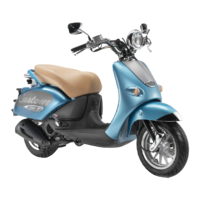7 - 63
PARTE CICLO CHASSIS PARTS
7.7.4 DESMONTAJE VARILLA-VASTAGO
Lea con cuidado 1.4 (PRECAUCIONES E INFORMA-
CIONES GENERALES).
◆ Para desmontar los detalles: tapón de goma (1), anillo
elástico de seguridad (seeger) (2), tapón de estan-
queidad (3), junto con el anillo “GACO” tipo junta tórica
(4) y muelle (5), realice las operaciones descritas en
7.7.1 (CONTROL NIVEL ACEITE) sobre la varilla vás-
tago que quiere desmontar, omitiendo las últimas dos
(de control nivel aceite).
Peligro de salida aceite.
El grupo varilla-vástago está lleno de aceite.
Al extraerlo no lo vuelque ni lo incline excesi-
vamente.
◆ Desmonte el grupo varilla-vástago, véase 7.7.3 (DES-
MONTAJE GRUPO VARILLA-VASTAGO (con horqui-
lla instalada)).
◆ Prepare un recipiente graduado con capacidad no in-
ferior a 200 cm
C.
◆ Introduzca del todo la varilla en el vástago, gire el gru-
po varilla-vástago y vacíe el aceite en el recipiente.
Controle la cantidad de aceite.
En caso de que ésta resulte inferior a 148 cm
C,
rellene o sustituya.
◆ Destornille y quite el tornillo (6) (fondo vástago) y guar-
de la arandela de cobre (7).
◆ Extraiga la varilla (8) junto con el hidráulico (9).
◆ Girando el vástago (10), recupere el útil de fondo (11)
y la contramuelle (12).
◆ Extraiga el guardapolvo (13).
◆ Extraiga el anillo elástico de seguridad (seeger) (14).
Durante la instalación ensamble el anillo elás-
tico de seguridad (seeger) (14) con la arista
viva contra la sede de la horquilla (mira figura).
◆ Extraiga el retén (15).
◆ Extraiga el distanciador (16).
◆ Extraiga el casquillo (17).
7.7.5 CONTROL DE LOS COMPONENTES
Varilla
◆ Controle que la superficie de deslizamiento no esté ra-
yada o tenga hendiduras.
Si las rayas son de tipo superficial, pueden eliminarse
utilizando papel de lija (tipo grano 1) mojado.
Si las rayas son profundas, sustituya la varilla.
◆ Utilizando un comparador controle que la eventual cur-
vatura de la varilla esté por debajo del valor límite.
En caso de que supere el valor límite, sustituya la varilla.
Límite de curvatura: 0,2 mm.
No hay que enderezar NUNCA una varilla cur-
vada porque se puede debilitar la estructura,
volviendo peligroso el uso del vehículo.
Vástago
◆ Controle que no esté dañado o que tenga hendiduras,
si acaso sustitúyalo.
Muelle
◆ Controle la integridad del muelle.
Hidráulico
Controle su integridad.
Si está dañado, sustitúyalo.
a
a
a
a
7.7.4 DISASSEMBLING THE TUBE/SLIDER UNIT
Carefully read 1.4 (PRECAUTIONS AND GENERAL IN-
FORMATION).
◆ For the disassembly of the rubber plug (1), retaining ring
(seeger) (2), seal plug (3) complete with “GACO” O-ring
(4), spring (5), carry out the operations described in
section 7.7.1 (CHECKING THE OIL LEVEL) on the
tube/slider unit that must be disassembled, excluding
the last two operations (oil level check).
Warning! The oil may flow out.
The tube/slider unit is full of oil. Neither over-
turn it, nor incline it excessively during the re-
moval.
◆ Remove the tube/slider unit, see 7.7.3 (REMOVING
THE TUBE/SLIDER UNIT (with installed fork)).
◆ Prepare a graduated container with at least 200 cmC
capacity.
◆ Make the tube get into the slider completely, rotate the
tube/slider unit and drain the oil in the container.
Check the oil quantity.
If it is lower than 148 cmC, top up or change.
◆ Unscrew and remove the screw (6) (slider bottom) and
take the copper washer (7).
◆ Withdraw the tube (8) complete with pumping element
(9).
◆ Take the bottom buffer (11) and the counterspring (12)
by rotating the slider (10).
◆ Remove the antidust gasket (13).
◆ Remove the retaining ring (seeger) (14).
Upon reassembly, position the retaining ring
(seeger) (14) with its sharp edge resting on
the adjacent elements (see figure).
◆ Remove the seal (15).
◆ Extract the cap (16).
◆ Extract the bushing (17).
7.7.5 CHECKING THE COMPONENTS
Tube
◆ Check the sliding surface, that must be neither lined,
nor scratched. Slight lines can be eliminated by sand-
ing the surface with wet sandpaper (grain 1).
If the lines are deep, change the tube.
◆ By means of a comparator, make sure that any curving
of the tube be lower than the limit value.
If it exceeds the limit value, change the tube.
Curving limit: 0.2 mm.
NEVER straighten a curved tube, since its
structure would be weakened, thus making
the use of the vehicle quite dangerous.
Slider
◆ Make sure that there are neither damages, nor cracks.
Otherwise, change it.
Spring
◆ Check the integrity of the spring.
Pumping element
Check the integrity of the pumping element.
If you observe any damage, change it.
a
a
a
a

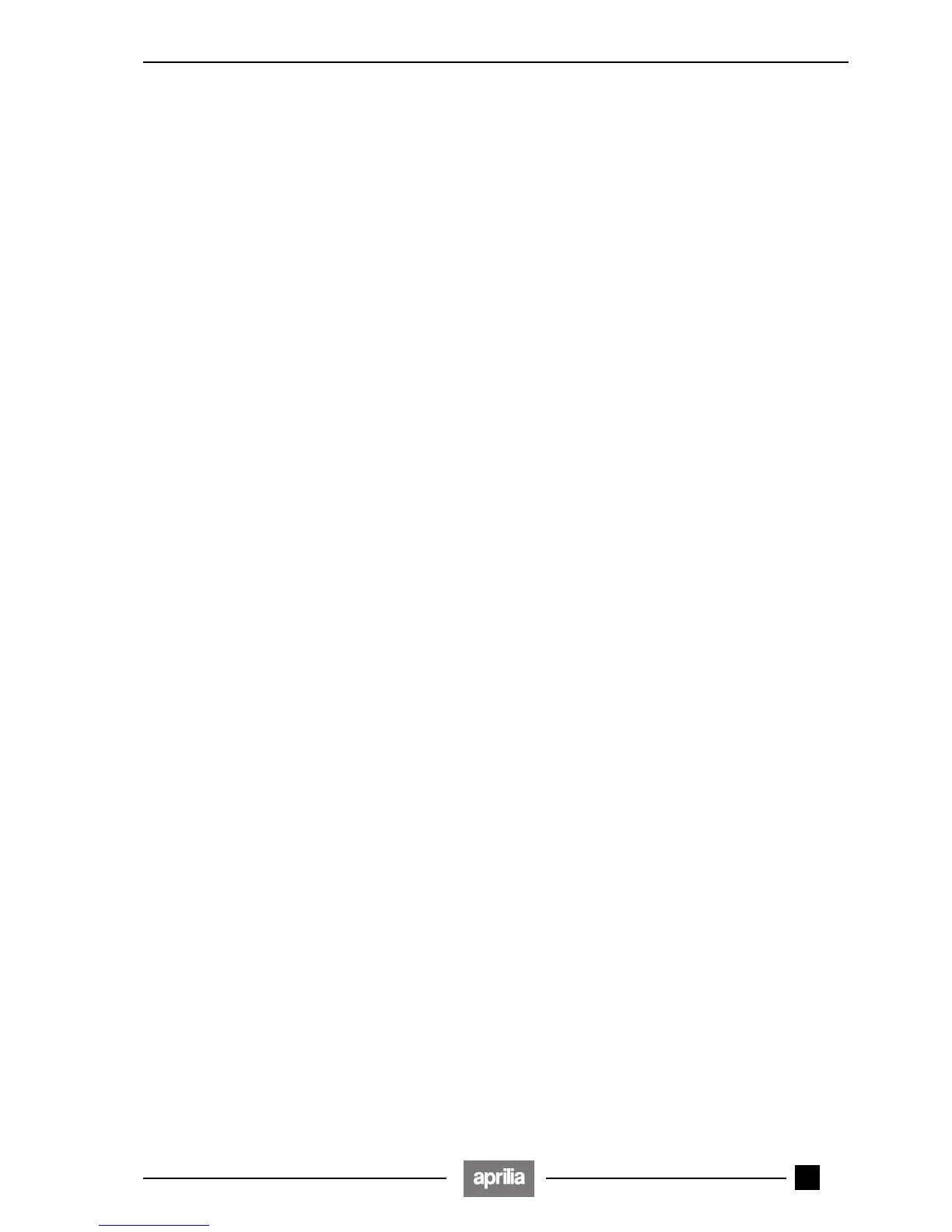